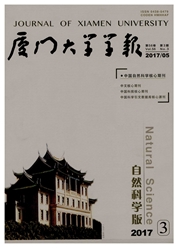

 中文摘要:
中文摘要:
记述了分别采自福建南部泉州沿诲、厦门同安湾和福建宁德东部等福建海域花水母亚纲3个新种,即福建隔膜水母Leuckartiara fujianensis,泉州枝萨水母Cladosarsia quanzhouensis和服刺铃水母Cnidocodon ocellata,详细描述了其形态特征,并与近似种进行了比较,为今后海洋生物资源调查提供参考.模式标本保存在厦门大学海洋学系.
 英文摘要:
英文摘要:
In this paper,it is reported that samples of anthomedusae collected from neritic water of Quanzhou and Tong'an bay of Xiamen during August 2006-May 2007 and a sample from the east sea water of Ningde of Fujian at July 1988. Through the analysis of 73 samples,three new species are found, i. e. Leuckartiara fujianensis n. sp. , Cladosarsia quanzhouensis n. sp. and Cnidocodon ocellata n. sp.. All type samples are deposited at the Department of Oceanography,Xiamen University. Specific characteristics of new species are described as follows: Leuckartiara fujianensis n. sp. (Fig. 1) The new species with conical apical projection)with large stomach attached to radial canals by mesenteries;mouth with much fol- ded and crenulated lips ; gonads interradial, horseshoe-shaped with folds directed peradially. So the new species belongs to the genus of Leuckartiara Hartlaub, 1914. At the present time only 19 valid species in Leuckartiara are known. This new species has four developed perradial tentacles. Only 8 species of Leuckartiara have 4 developed tentacles, i. e. L. abyssi (G. O. Sars, 1874) ,L. brownei Larson and Harbison, 1990, L. eckerti Bouillon, 1985, L. gardineri Browne, 1916, L. jiangyinensis Xu and Huang, 2004, L. neustona Xu and Huang, 2005, L. simplex Bouillon, 1980, and L. zhangraoting Xu and Huang, 2006. The differences of the new species from these species of Leuckartiara are showed in Table 1. The main characteristics of the new species:umbrella with conical apical projections4 developed perradial tentacles, with lateral depressed bulbs, with a abaxial long spur and with ring cnidoblast;4 rather large interradial club-shaped rudimentary tentacles and 8 small adradial club-shaped rudimentary tentacles, without tentacles bulbs, with adnate to the exumbrella at bell margin, all tentacles none ocelli;2 adradial series of gonads connected in the uppermost part and medium transverse bridges. The closest species is L. jianyinensis Xu et Huang, 2005, which also has 4 developed marginal tentacles, 4
 同期刊论文项目
同期刊论文项目
 同项目期刊论文
同项目期刊论文
 期刊信息
期刊信息
